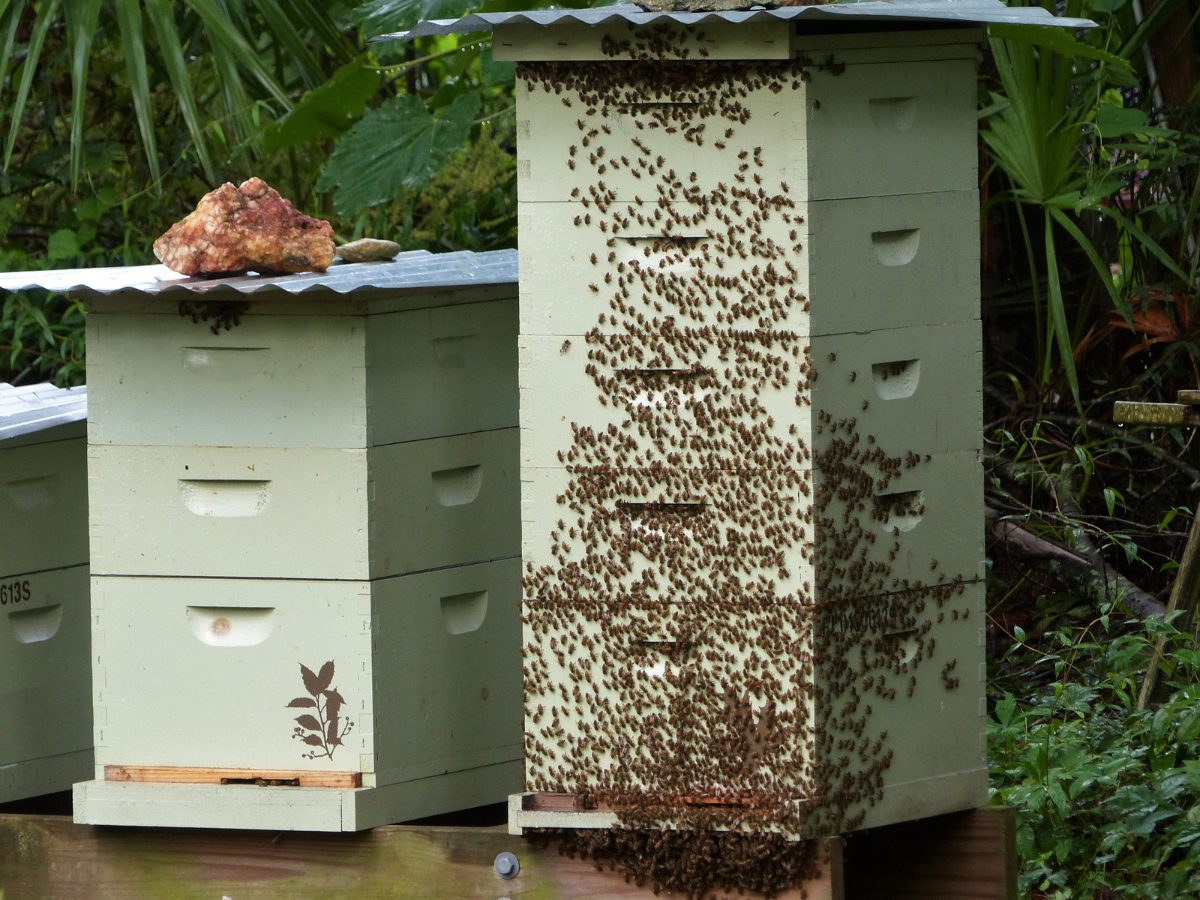When the hive becomes too crowded, there is a high chance of being swarmed away. The best way to prevent swarming is by splitting the hive.
Splitting a beehive means converting one crowded hive into two different hives.
It is important to know how to split a beehive properly to prevent swarming. So, you must know the proper way of splitting a hive.
Because if you do anything wrong while splitting the hive, you probably gonna lose your both hives.
Don’t worry! Following my guide, you will be able to split a beehive properly and you won’t lose your bees again.
Signs Of A Hive Is Preparing To Swarm
There are some common signs by observing which you can say whether a hive is preparing for swarming or not. Those include the following.
- Too crowded hive: If your hive becomes too crowded and there doesn’t have enough space for broods to grow up. Then there is a high chance that your bees will swarm away soon.
- Abandoned food storage: If there is some food storage that is abandoned by your bees then this could be a sign of swarm preparation.
- The large population of drone & worker bees: When there is an undesirable rise in the population of worker and drone bees, the queen may swarm with a portion of drone and worker bees for a new home.
- Season: During the late spring and fall seasons bees are more likely to swarm away. During these 2 seasons, bees have the maximum population. Also, during fall bees become more aggressive. These sometimes lead the hive to swarm away.
- Presence of new queen: Mainly when there is a new queen developing inside the same hive, the old queen may swarm away with some drone and worker bees.
- Presence of idle worker Bees: Worker bees usually do not work much in old age. They usually spend idle time or just carry water to the hive during their last few days of life. When you notice a large amount of idle worker bees inside a hive that can also be an indication that your hive is preparing to swarm away.
Will Splitting A Hive Stop Swarming?
Yes, if you can properly and safely split a hive then your bees won’t swarm away. Because in most cases bees swarm away when there is a shortage of space for the colony. So, if you split one hive into 2 full-sized hives, bees will have enough space to live peacefully and they won’t swarm away.
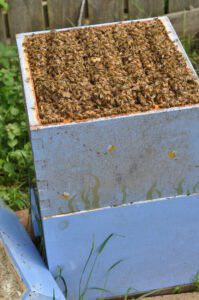
An overcrowded hive makes bees aggressive and the colony runs into trouble with brood development.
Also, if there are multiple queens in the same hive, the old queen will try to kill the new one. So, the nurse bees will decide to take away the new queen to build a new colony.
If you split the hive under these circumstances then they don’t need to swarm away. That’s why splitting a hive will effectively prevent swarming.
How To Split A Beehive
The common method that famous beekeepers use to split a beehive is by placing 2 brood frames, 2 honey, and pollen-containing frame, and 1 frame having a queen cage in a 5 frame-sized beehive.
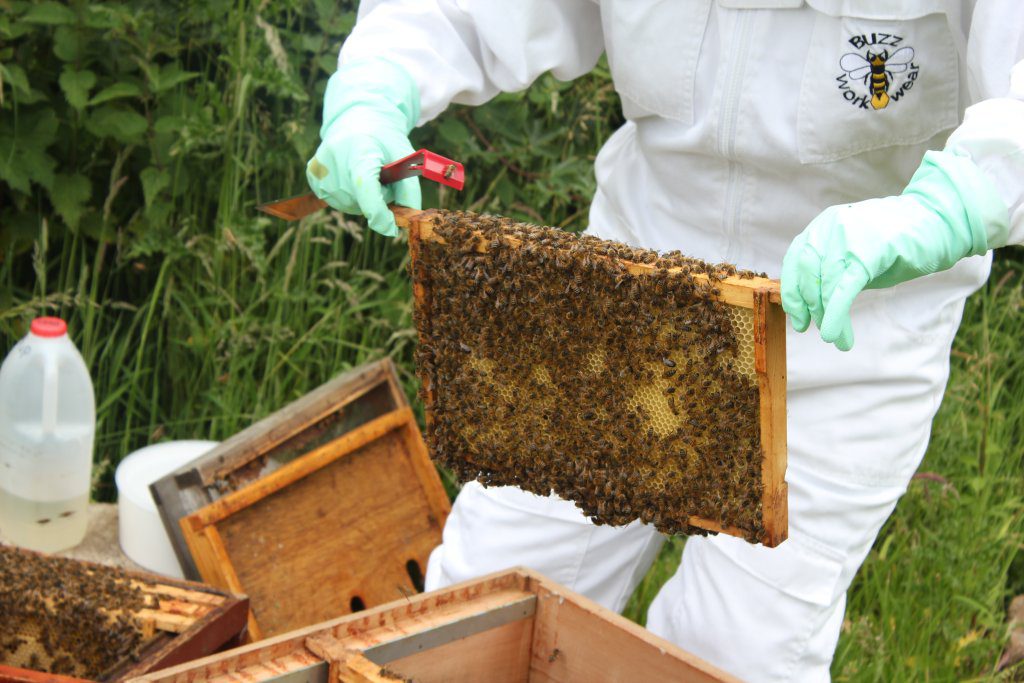
But before splitting a beehive at first you have to know the perfect time when you require to split the hive. After determining the right timing for splitting a beehive you should split the hive safely.
Do Beehives Split Naturally?
Yes, beehives split naturally by swarming away from their current home. When the current hive becomes overpopulated or inappropriate for living, the queen will swarm away with some worker and drone bees.
Before swarming, the worker bees will go outside and try to find a new suitable place to build their nest.
Within a few days, the new nest will be made. Then the queen will split a portion of the colony and swarm to the new hive.
To prevent swarming away, a beekeeper must split the hive while the hive is preparing to swarm.
How Do You Know When To Split A Beehive?
There are some signs which will indicate the right time to split a beehive. Most of them are as below:
- Swarm preparation: When you find any sign of swarm preparation by the colony then that will be the best time to split a beehive.
- Within Fall and late Spring: Within these seasons bees become maximum in number inside a hive. So, you must split the hive during one of these seasons to give them enough space to live.
- When a new queen cell is present: If you find a new queen brood is present inside the hive then you must split the hive to save her. Because the current queen won’t allow the presence of a new queen inside the hive. Though the new queen is engendered by the present queen, still she will kill the new queen. That’s why to save the new queen you have to split the hive as early as possible.
When you see any of the above signs you must split the hive as soon as possible.
What Is The Best Time Of Day To Split A Beehive?
The best time of the day to split a beehive is the early morning and the evening before getting entirely dark. Most beekeepers like to split a beehive in the morning while almost all bees are present inside the hive.
Whenever you are thinking of splitting a hive make sure the weather is nice and chill. Don’t split the hive when it is too cold, too warm, cloudy, or raining. You must follow the hive inspection rules before approaching to split the hive.
How To Split A Beehive With A New Queen
Before approaching to split a beehive you should take some protective gear and necessary tools for the hive splitting.
The following are the required elements you must get before approaching the hive splitting.
- Wear beekeeping suits, and gloves, and cover your entire body to prevent getting stung by bees.
- Take a bee smoker.
- A good quality 5-frame or any other full-sized empty hive or even an abandoned beehive if it is in good condition. This will be the new home for the separated colony.
- Hive tools.
The hive-splitting technique is almost similar to transferring nuc to a full-sized hive. However, you can start splitting the hive by following the steps below.
- Step-1: Place the new empty hive close to the present one that you are going to split.
- Step-2: Clean the empty hive and remove all the empty frames from the hive first.
- Step-3: Now place 2 empty frames at one end of the hive.
- Step-4: Open the entrance of the present hive that we are going to split. You can push some smoke upon the entrance of the hive to calm the bees.
- Step-5: Using the hive tool lift the frames one by one and inspect them carefully. Look for the queen cage containing frames, frames containing only brood, and frames having honey and pollen.
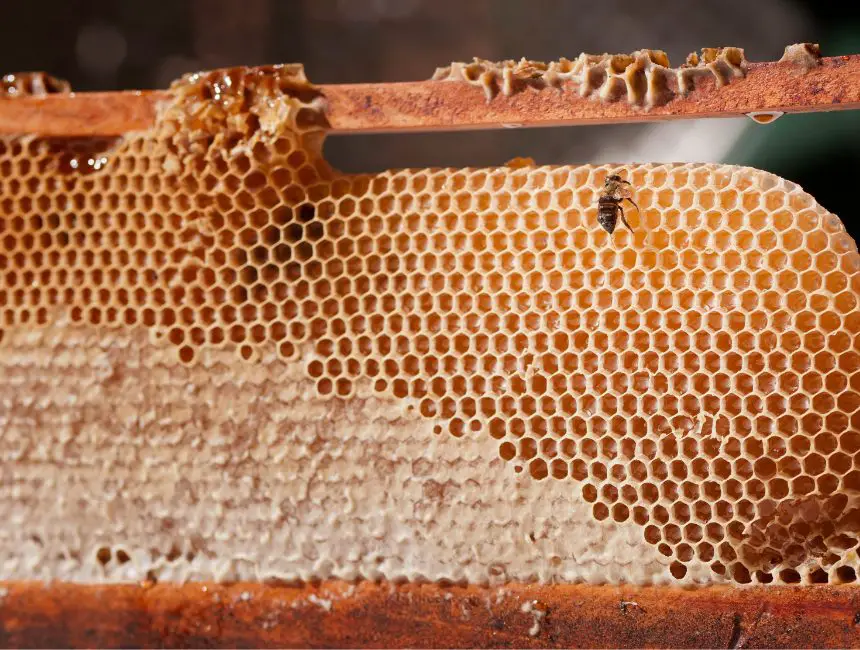
- Step-6: Now you have to take 2 frames having honey and pollen and place them at the 1st and 5th position of the empty hive. These 2 frames can have some eggs and larvae too.
- Step-7: Take 2 brood and worker bees containing frames and place them at the 2nd and 4th position of the new hive. These frames can also contain some honey and pollen but make sure there are a large amount of broods.
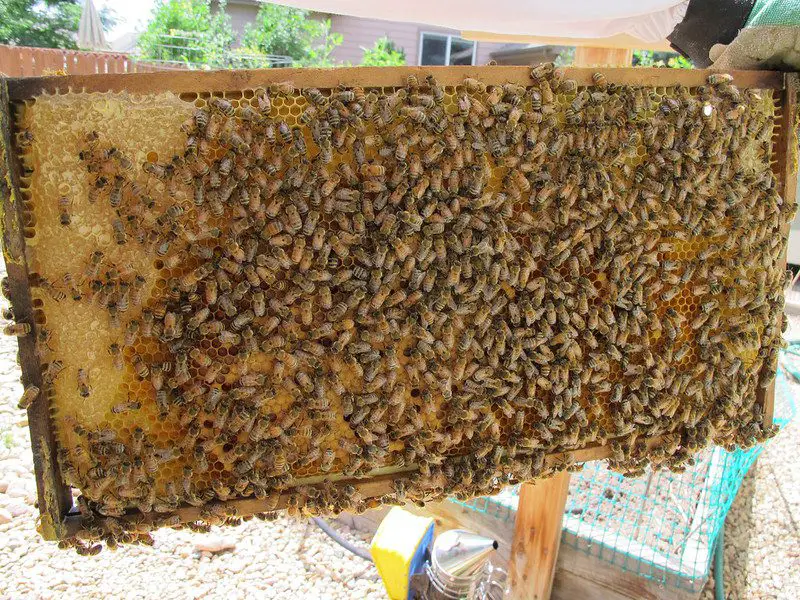
- Step-8: Now find the frame that contains the queen cage from the present hive. Lift it and place it in the middle position of the new hive. You can move the frame having either the new queen cage or the old queen cage. But make sure the old hive has at least one queen-containing cage.
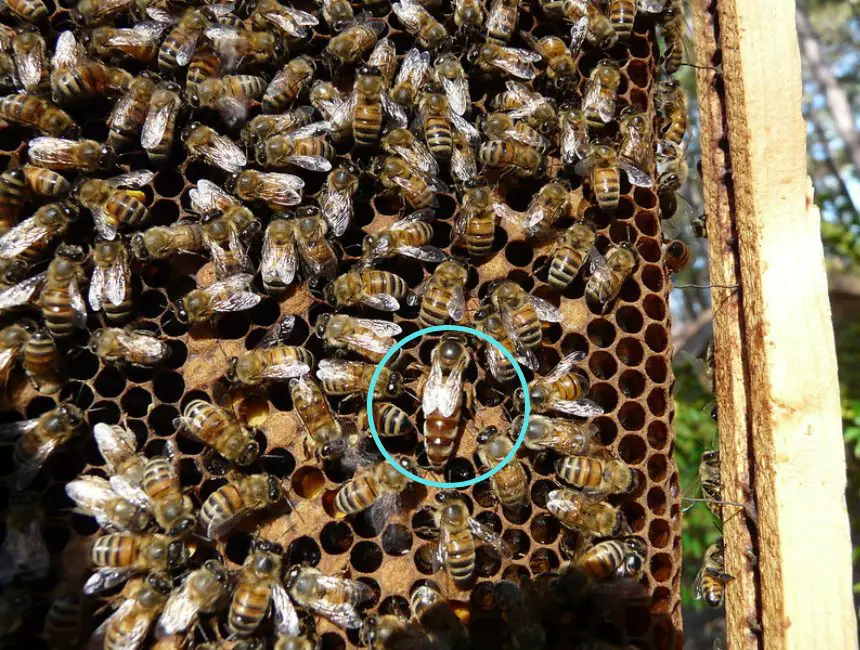
- Step-9: Place 2 empty frames at the other end of the hive. So, 2 empty frames at one end of the hive, and another 2 empty frames will be at the other end of the hive. That’s it you are done with splitting the hive and placing the portion of the colony in a new hive.
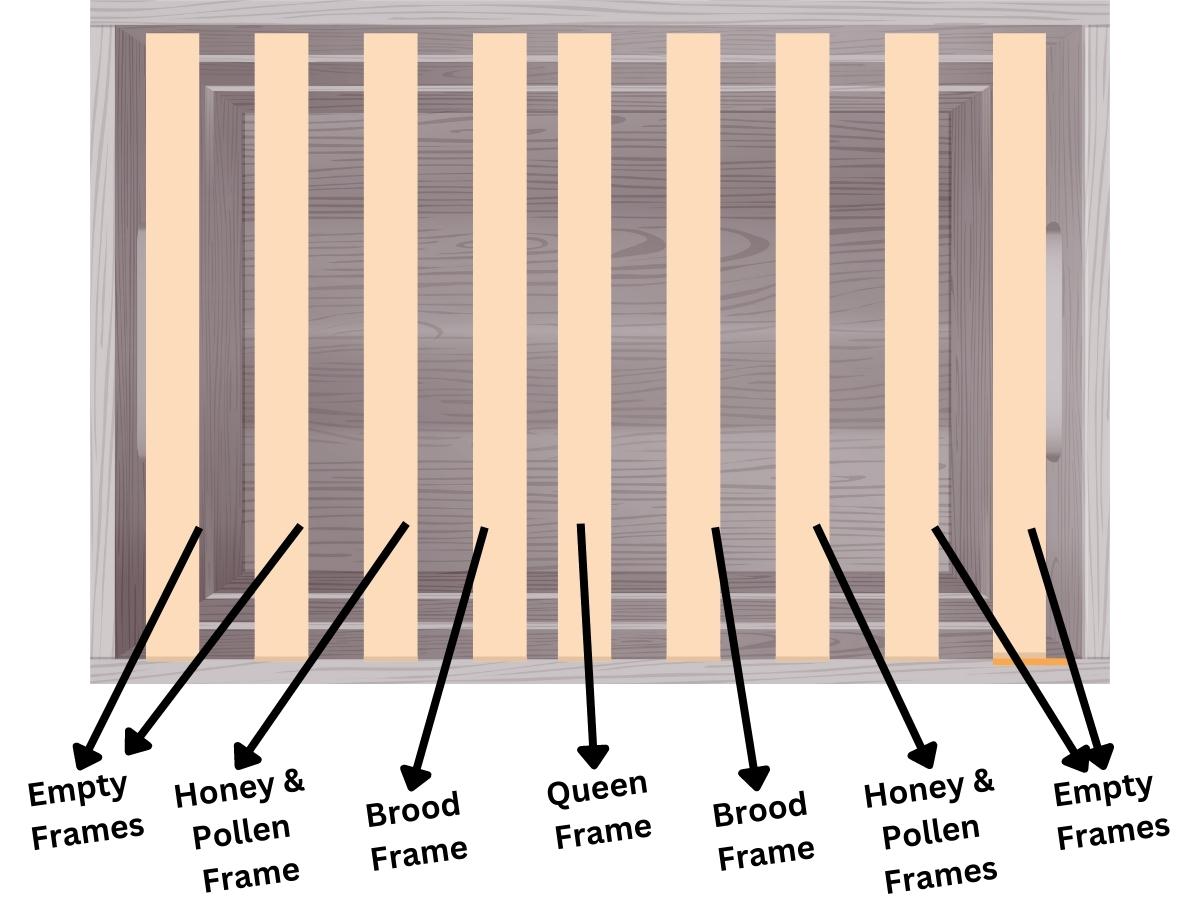
If you have completed all the above steps properly then congratulations you have successfully done the splitting of a beehive.
During the hive splitting you can push some smoke upon bees. But don’t overdo it. You should have at least the knowledge of how to use a bee smoker properly to calm your bees.
The next step is feeding the new hive and inspecting both hives regularly for a few days.
Note: After splitting a hive into 2 hives there is a risk of getting attacked by the varroa mites. So, you should be aware of that. If you find any of your hives showing symptoms of getting attacked by varroa mites or any diseases then take the necessary steps to help the colony to survive.
After a few days, bees will adapt to their new hive and start making a healthy colony on their own.
Can You Split A Hive Without A Queen?
Yes, you can split a hive without a queen. But make sure within a few days after splitting the hive, you have to introduce a new queen to the hive.
Because no honey bee colony can survive without a queen for a long period of time. The queen releases pheromones that lead the worker bees and run the entire colony.
Without having any queen the colony members won’t be able to do their daily work properly to run the colony. So, they will die or swarm away soon.
You can also check if any of the larvae containing existing frames from the old hive contain queen larvae or not. If so, you don’t have to purchase or bring any other queen to sell from anywhere else. The nurse bee will raise the new queen from any of the existing larvae on its own.
Keep an eye on their behavior if you don’t notice any queen after a few days. Then you have to bring and introduce a new queen to the hive.
How To Split A Beehive Without A Queen
The hive-splitting technique without a queen is similar to the splitting technique with a queen cage. The difference is there will be no queen cage containing a frame in the middle of the new hive.
- Instead of a queen cage place a frame having nurse bees and some broods a the middle of the new hive.
- Then order a new queen cage from your nearest Nuc seller. You can also get a new queen from your nearest beekeeper they might help you by providing a queen bee.
- After getting the queen you have to introduce the queen to the new hive that doesn’t have any queen.
- After introducing the queen to the hive you don’t have to do anything. The queenless hive will automatically adapt and accept its queen very soon.
You can get help from our another article on 6 ways to requeen a queenless hive.
What To Do After Splitting A Hive?
After splitting the hive properly the swarm prevention isn’t yet confirmed. If bees do not find the house safe for their living they won’t stay there. They will swarm away.
So, you have to take care of both hives the old one and the new one. First, move the new hive far from the old one so that the bees accept their new home and don’t fly to their old home.
Make sure to feed them properly if needed. Within a few days, both colony members will adopt and they won’t swarm away. Moreover, you will have 2 healthy colonies from 1 colony.
How Far To Move The Splitted Beehive
Most beekeepers move the new beehive after splitting 3 miles far from its original hive. But I usually used to move the new hive approximately 2 to 2.5 miles away from the previous hive.
If you don’t move the new hive from the original hive at a minimum distance, there is a high chance that the bees will get back to their old hive. Thus the new hive will be destroyed as there will be no nurse bees to take care of broods and larvae.
So, you must move the new hive at a distance of at least 2 miles from the parent hive. If you can move it far from this distance, it would be more safe.
But don’t worry you don’t need to keep them far for a long time. Keep them far from your current apiary for a few days. When they adapt and accept their new home, you can bring them to your old apiary.
Frequently Asked Questions
What is the easiest way to prevent swarming?
The easiest way to prevent swarming is by giving them enough space & food to live happily. In case, the hive becomes too crowdy you should split the hive. Also, winterize the hive properly before the winter. The main thing is to ensure a suitable environment inside the hive, so that bees can live peacefully.
Can you split a hive every year?
Of course. You can split a hive every year when you find the hive has become overcrowded and/or a new queen is starting to grow up. This is a popular way to expand colonies.
When is it too late to split a hive?
You should split the hive in the late spring or within the fall season. Late September or later will be too late to split a hive.
Final Words & Helpful Resources
Splitting a hive properly and safely will prevent bees from swarming away. Not only for swarm prevention but also for growing the number of colonies, splitting hives is a great and effective way.
By learning the proper way to split a beehive you will be able to increase your colony size and honey production.
The following references might be helpful for you.
- Utah State University- Splitting the hive. You can read this here.
- I. Nolasco, A. Terenzi, S. Cecchi, S. Orcioni, H. L. Bear, and E. Bene, “Audio-based identification of beehive states,” IEEE, Conference Date: 12-17 May 2019. To read the research paper click here.
- Read this article for the beekeeping cost estimation guide.
Regards
Beekeepingstudy

